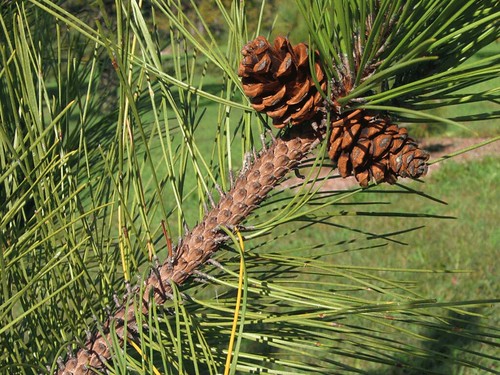red pine
(Pinus resinosa)
Conservation • Wetland • Description • Habitat • Ecology • Use • Distribution • Taxonomy
Description |
||
Red pine is an evergreen, coniferous tree rising on a single trunk from numerous lateral roots with vertical sinkers and often a taproot. It is a hard pine. It is typically found in small groves of trees. In Minnesota mature trees are usually 40′ to 60′ tall and up to 36″ in diameter, though in favorable conditions it can reach over 100′ in height. Young trees are oval in shape with a cone-shaped crown. Older trees have a narrowly rounded crown. The trunk is straight. The bark on young trees is reddish to pinkish with loose, brown-gray scales. On mature trees the bark is thick, light reddish-brown, furrowed and cross-checked into broad, flat, irregularly rectangular, scaly plates. The branches are stout, horizontal and whorled, each whorl representing one year of growth. The tree’s age can be determined by counting the number of whorls from the bottom up. Branches near the crown are ascending. Lower and middle branches are horizontally spreading, often drooping with the tips somewhat ascending. Older branches toward the bottom die and fall off. The twigs are moderately slender, orange to reddish-brown, hairless, shiny, grooved, and ridged. They are not glaucous. They become darker brown and rough and scaly as they age. The buds are egg-shaped or cone-shaped, ⅝″ to ¾″ long, slightly pointed, and not very resinous. They are covered with loose, overlapping, orangish-brown to reddish-brown scales. The margins of the scales have a fringe of white hairs. The needle-like leaves are dark green and shiny, with narrow bands of white dots. They are 4″ to 6″ long, slender, straight or slightly twisted, sharp-pointed, and brittle. If bent they will snap cleanly. In cross section they are triangular in shape and have two fibrovascular bundles. The white dots are pores surrounded by 2 glaucous cells, and are evident on all surfaces. Needle edges are finely toothed. Needles are borne in bundles of 2 with a sheath at the base. The sheath is ⅜″ to 1″ long, and does not fall off before the needles. The needles are evergreen, remaining on the tree 4 to 5 years. Male and female cones are borne on the same tree. Pollen (male) cones are cylindrical, ⅜″ to ¾″ long, and purple. They are borne in clusters on older branches in the lower part of the crown at the base of the the previous year’s shoots. Female cones at the time of pollination are red, spherical, ⅛″ long conelets. They are borne usually in clusters near the tip of the new shoots. On younger trees they are in the middle third of the crown, on older trees they are in the upper third of the crown. Pollination takes place in late May or early June. Male cones shed pollen then wither and fall away. Fertilization takes place 13 months after pollination. After fertilization the conelets elongate quickly, reaching full size, 1½″ to 2¼″ long, by mid-July. Mature seed cones are light red-brown, woody, egg-shaped, and symmetrical. They are nearly stalkless, usually in pairs, and point outward from the stem. They are covered with spiraling rows of scales. The scales at the tip and the base are small and are not fertile. Mature seed cone scales are thin and rounded at the tip. The tip of the scale, that portion that is exposed when the cone is closed (apophysis), is grayish-brown to tan or greenish-gray, slightly thickened, slightly raised, with a low ridge from side to side. There is a sealing band adjacent to the apophysis where the scales meet when closed. There is a prominent protuberance (umbo) centrally located on the apophysis, on the ridge. There is no prickle on the umbo. The scale tip is pressed closely against the next scale, not free. At maturity the scales bend backward, releasing the seeds. Soon after that the cones fall to the ground. There are 2 seeds in each fertile scale. The seeds are brown, mottled with black, egg-shaped, 3 ⁄32″ to 3 ⁄16″ long, with a ⅜″ to ⅝″ long, pale brown wing. The wing is loosely attached to the seed (articulate), and is easily pulled away. |
||
Height |
||
40′ to 60′ |
||
Record |
||
There are two co-champion red pines in Minnesota. One is on public property near Dora lake in Itasca County. In 2010 it was measured at 120′ tall and 116″ in circumference (37″ in diameter), with a crown spread of 41′. One is on public property near Ash River in St. Louis County. In 2019 it was measured at 120′ tall and 119″ in circumference (38″ in diameter), with a crown spread of 45′. |
||
Similar Species |
||
Austrian pine (Pinus nigra) needles are flexible, not brittle, and do not snap in two when bent. The seed cones are yellowish brown and have prickles. It does not occur in Minnesota. |
||
Habitat |
||
Dry. Pure stands or mixed with jack pine, eastern white pine, quaking aspen, or northern pin oak. Sandy soil. Full sun. |
||
Ecology |
||
Pollination |
||
Late May or early June |
||
Pests and Diseases |
||
|
||
Use |
||
Red pine is Minnestoa’s state tree. |
||
Distribution |
||||
|
Sources |
|||
| 4/14/2023 | ||||
Nativity |
||||
Native |
||||
Occurrence |
||||
Common |
||||
Taxonomy |
|||
| Kingdom | Plantae (Plants) | ||
| Phylum | Tracheophyta (Vascular Plants) | ||
| Subdivision | Spermatophytina (Seed Plants) | ||
| Class | Pinopsida (conifers) | ||
| Subclass | Pinidae | ||
Order |
Pinales (conifers) | ||
Family |
Pinaceae (pine) | ||
| Subfamily | Pinoideae (pines, spruces, larches, and allies) | ||
Genus |
Pinus (pines) | ||
| Subgenus | Pinus (hard pines) | ||
| Section | Pinus (Eurasian, red, and tropical pines) | ||
| Subsection | Pinus | ||
Subordinate Taxa |
|||
|
|||
Synonyms |
|||
|
|||
Common Names |
|||
American red pine Canadian red pine Norway pine red pine |
|||
Glossary
Apophysis
In coniferous trees that portion of the cone scale that is exposed when the cone is closed. It is the second year’s growth of a two year old scale.
Glaucous
Pale green or bluish gray due to a whitish, powdery or waxy film, as on a plum or a grape.
Hard pines
Pines of the subgenus Pinus. They have scales with a sealing band, dorsal umbos, articulate seed wings, and two fibrovascular bundles per leaf. The wood is harder and heavier than that of soft pines. Also called typical pines or yellow pines.
Umbo
A blunt or round protuberance on the end of the scale of some pine cones. It is the first year’s growth of a two year old scale.
Vascular bundle
(fibrovascular bundle) A strand of the transport system in plants that runs from the roots, through the stems, to the leaves. It consists of xylem on the inside and phloem on the outside.
Wing
A thin, flat, membranous, usually transparent appendage on the margin of a structure.
Visitor Photos |
|||||
Share your photo of this plant. |
|||||
| This button not working for you? Simply email us at info@MinnesotaSeasons.com. Attach one or more photos and, if you like, a caption. |
|||||
Randy |
|||||
Red pine, Freeborn County, MN, October 2017 |
|||||
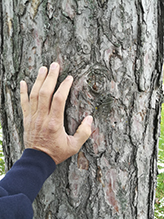 |
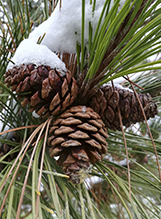 |
||||
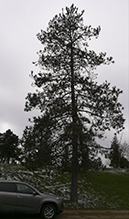 |
|||||
Red pine trunk |
|||||
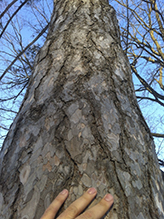 |
|||||
Red pine bark |
|||||
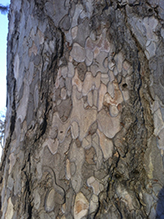 |
|||||
MinnesotaSeasons.com Photos |
|||||
Bark |
|||||
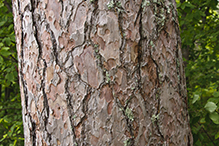 |
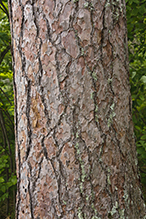 |
||||
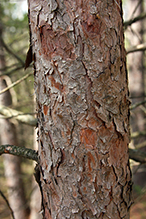 |
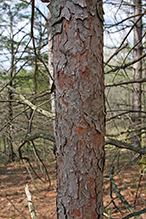 |
||||
Male Cones |
|||||
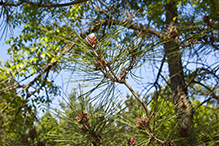 |
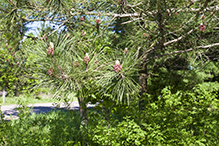 |
||||
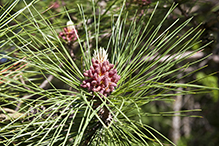 |
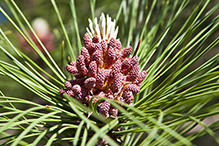 |
||||
Needles |
|||||
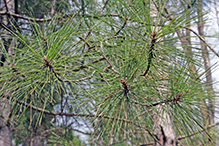 |
|||||

Visitor Videos |
|||
Share your video of this plant. |
|||
| This button not working for you? Simply email us at info@MinnesotaSeasons.com. Attach a video, a YouTube link, or a cloud storage link. |
|||
Other Videos |
|||
| Trees with Don Leopold - red pine ESFTV |
|||
About
Published on Jun 12, 2012 No description available. |
|||
| Pine Tree Identification ScienceOnline |
|||
About
Uploaded on Feb 18, 2012 This video demonstrates the basics of identifying three common, native pine trees of Eastern North America, White, Red and Jack Pine. The non-native Scots pine is included as it can be confused with Jack Pine. Filmed in the Shaw Woods, http://shawwoods.ca |
|||
| Pinus Resinosa TheCampusTrees |
|||
About
Published on Apr 25, 2012 University of Minnesota Assistant Professor Anthony D'Amato discusses the functionality of red pine. Show more |
|||

Visitor Sightings |
|||||
Report a sighting of this plant. |
|||||
| This button not working for you? Simply email us at info@MinnesotaSeasons.com. Be sure to include a location. |
|||||
| Randy October 2017 |
Location: Freeborn County, MN |
 |
|||
| Randy 12/22/2016 |
Location: Freeborn Co. Red pine bark |
 |
|||
MinnesotaSeasons.com Sightings |
|||||
Badoura Jack Pine Woodland SNA Bertram Chain of Lakes Regional Park Carpenter St. Croix Valley Nature Center Charles A. Lindbergh State Park Itasca Wilderness Sanctuary SNA Kellogg Weaver Dunes SNA, Kellogg Weaver Unit Minnesota Valley NWR, Long Meadow Lake Unit Mound Spring Prairie SNA, North Unit Robert Ney Memorial Park Reserve |
|||||

|
Created: Last Updated: © MinnesotaSeasons.com. All rights reserved. |

